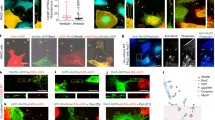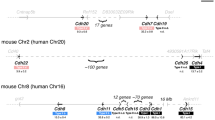Abstract
Eph proteins are receptors with tyrosine-kinase activity which, with their ephrin ligands, mediate contact-dependent cell interactions1 that are implicated in the repulsion mechanisms that guide migrating cells and neuronal growth cones to specific destinations2,3. Ephrin-B proteins have conserved cytoplasmic tyrosine residues that are phosphorylated upon interaction with an EphB receptor4,5, and may transduce signals that regulate a cellular response6. Because Eph receptors and ephrins have complementary expression in many tissues during embryogenesis7, bidirectional activation of Eph receptors and ephrin-B proteins could occur at interfaces of their expression domains, for example at segment boundaries in the vertebrate hindbrain. Previous work8,9 has implicated Eph receptors and ephrin-B proteins in the restriction of cell intermingling between hindbrain segments10. We therefore analysed whether complementary expression of Eph receptors and ephrins restricts cell intermingling, and whether this requires bidirectional or unidirectional signalling. Here we report that bidirectional but not unidirectional signalling restricts the intermingling of adjacent cell populations, whereas unidirectional activation is sufficient to restrict cell communication through gap junctions. These results reveal that Eph receptors and ephrins regulate two aspects of cell behaviour that can stabilize a distinct identity of adjacent cell populations.
This is a preview of subscription content, access via your institution
Access options
Subscribe to this journal
Receive 51 print issues and online access
$199.00 per year
only $3.90 per issue
Buy this article
- Purchase on Springer Link
- Instant access to full article PDF
Prices may be subject to local taxes which are calculated during checkout




Similar content being viewed by others
References
Davis, S. et al. Ligands for EPH-related receptors that require membrane attachment or clustering for activity. Science 266, 816–819 (1994).
Flanagan, J. G. & Vanderhaeghen, P. The ephrins and Eph receptors in neural development. Annu. Rev. Neurobiol. 21, 309–345 (1998).
O'Leary, D. D. M. & Wilkinson, D. G. Eph receptors and ephrins in neural development. Curr. Opin. Neurobiol. 9, 65–73 (1999).
Holland, S. J. et al. Bidirectional signalling through the Eph-family receptor Nuk and its transmembrane ligands. Nature 383, 722–725 (1996).
Bruckner, K., Pasquale, E. B. & Klein, R. Tyrosine phosphorylation of transmembrane ligands for Eph receptors. Science 275, 1640–1643 (1997).
Henkemeyer, M. et al. Nuk controls pathfinding of commisural axons in the mammalian central nervous system. Cell 86, 35–46 (1996).
Gale, N. W. et al. Eph receptors and ligands comprise two major specificity subclasses, and are reciprocally compartmentalised during embryogenesis. Neuron 17, 9–19 (1996).
Xu, Q., Alldus, G., Holder, N. & Wilkinson, D. G. Expression of truncated Sek-1 receptor tyrosine kinase disrupts the segmental restriction of gene expression in the Xenopus and zebrafish hindbrain. Development 121, 4005–4016 (1995).
Xu, Q., Mellitzer, G., Robinson, V. & Wilkinson, D. G. In vivo cell sorting in complementary segmental domains mediated by Eph receptors and ephrins. Nature 399, 267–271 (1999).
Fraser, S., Keynes, R. & Lumsden, A. Segmentation in the chick embryo hindbrain is defined by cell lineage restrictions. Nature 344, 431–435 (1990).
Eph Nomenclature Committee. Unified nomenclature for Eph family receptors and their ligands, theephrins. Cell 90, 403–404 (1997).
Stein, E. et al. Eph receptors discriminate specific ligand oligomers to determine alternative signaling complexes, attachment, and assembly responses. Genes Dev. 12, 667–678 (1998).
Torres, R. et al. PDZ domains bind, cluster, and synaptically colocalize with Eph receptors and their ephrin ligands. Neuron 21, 1453–1463 (1998).
Wang, H. U. & Anderson, D. J. Eph family transmembrane ligands can mediate repulsive guidance of trunk neural crest migration and motor axon outgrowth. Neuron 18, 383–396 (1997).
Krull, C. E. et al. Interactions of Eph-related receptors and ligands confer rostrocaudal pattern to trunk neural crest migration. Curr. Biol. 7, 571–580 (1997).
Martinez, S., Geijo, E., Sanchez-Vives, M. V., Puelles, L. & Gallego, R. Reduced junctional permeability at interrhombomeric boundaries. Development 116, 1069–1076 (1992).
Bagnall, K. M., Sanders, E. J. & Berdan, R. C. Communication compartments in the axial mesoderm of the chick embryo. Anat. Embryol. 186, 195–204 (1992).
Kumar, N. H. & Gilula, N. B. The gap junction communication channel. Cell 84, 381–388 (1996).
Bruzzone, R., White, T. W. & Paul, D. L. Connections with connexins: the molecular basis of direct intercellular signaling. Eur. J. Biochem. 238, 1–27 (1996).
Takeichi, M. Cadherin cell adhesion receptors as a morphogenetic regulator. Science 251, 1451–1455 (1991).
Gumbiner, B. M. Cell adhesion: the molecular basis of tissue architecture and morphogenesis. Cell 84, 345–357 (1996).
Wizenmann, A. & Lumsden, A. Segregation of rhombomeres by differential chemoaffinity. Mol. Cell. Neurosci. 9, 448–459 (1997).
Zisch, A. H. et al. Tyrosine phosphorylation of L1 family adhesion molecules: implication of the Eph kinase Cek5. J. Neurosci. Res. 47, 655–665 (1997).
Bruckner, K. & Klein, R. Signaling by Eph receptors and their ephrin ligands. Curr. Opin. Neurobiol. 8, 375–382 (1998).
Lo, C. W. The role of gap junction membrane channels in development. J. Bioenerg. Biomemb. 28, 379–385 (1996).
Simon, A. M. & Goodenough, D. A. Diverse functions of vertebrate gap junctions. Trends Cell Biol. 8, 477–483 (1998).
Martinez, S., Marin, F., Nieto, M. A. & Puelles, L. Induction of ectopic engrailed expression and fate change in avian rhombomeres: intersegmental boundaries as barriers. Mech. Dev. 51, 289–303 (1995).
Warner, A. E. & Lawrence, P. A. Permeability of gap junctions at the segmental border in insect epidermis. Cell 28, 243–252 (1982).
Acknowledgements
We thank M. Henkemeyer, N. Gale and G. Yancopoulos for reagents, and J.-P. Vincent and R.Krumlauf for helpful discussions and comments on the manuscript. This work was supported by an EMBO Postdoctoral Fellowship to G.M., the MRC and a European Commission Biotechnology grant.
Author information
Authors and Affiliations
Corresponding author
Rights and permissions
About this article
Cite this article
Mellitzer, G., Xu, Q. & Wilkinson, D. Eph receptors and ephrins restrict cell intermingling and communication. Nature 400, 77–81 (1999). https://doi.org/10.1038/21907
Received:
Accepted:
Issue Date:
DOI: https://doi.org/10.1038/21907
This article is cited by
-
Unraveling the Potential of EphA4: A Breakthrough Target and Beacon of Hope for Neurological Diseases
Cellular and Molecular Neurobiology (2023)
-
Redundant type II cadherins define neuroepithelial cell states for cytoarchitectonic robustness
Communications Biology (2020)
-
Neural stem cells deriving from chick embryonic hindbrain recapitulate hindbrain development in culture
Scientific Reports (2018)
-
Cell type-specific localization of Ephs pairing with ephrin-B2 in the rat postnatal pituitary gland
Cell and Tissue Research (2017)
-
Increased epithelial-free areas in thymuses with altered EphB-mediated thymocyte–thymic epithelial cell interactions
Histochemistry and Cell Biology (2017)
Comments
By submitting a comment you agree to abide by our Terms and Community Guidelines. If you find something abusive or that does not comply with our terms or guidelines please flag it as inappropriate.



